Comparative Analysis: Residential Schools Experiences Essay
VerifiedAdded on 2023/06/08
|5
|978
|269
Essay
AI Summary
This essay examines the tragic history of Canadian Residential Schools, focusing on the experiences of Indigenous children. It compares and contrasts historical accounts with survivor testimonies, specifically referencing the "They Came for the Children" report and testimonies from the "Where are the Children" website. The essay explores the similarities and differences between these sources, considering their form, narrators, and perspectives. It analyzes the impact of residential schools on Indigenous culture, language, and family structures, highlighting the forced assimilation, abuse, and cultural destruction inflicted upon the children. The essay also discusses the historical context, the role of the Canadian government and religious organizations, and the long-lasting effects of these institutions on Indigenous communities. Through concrete examples and MLA-style citations, the essay provides a comprehensive overview of the residential school system and its devastating legacy.
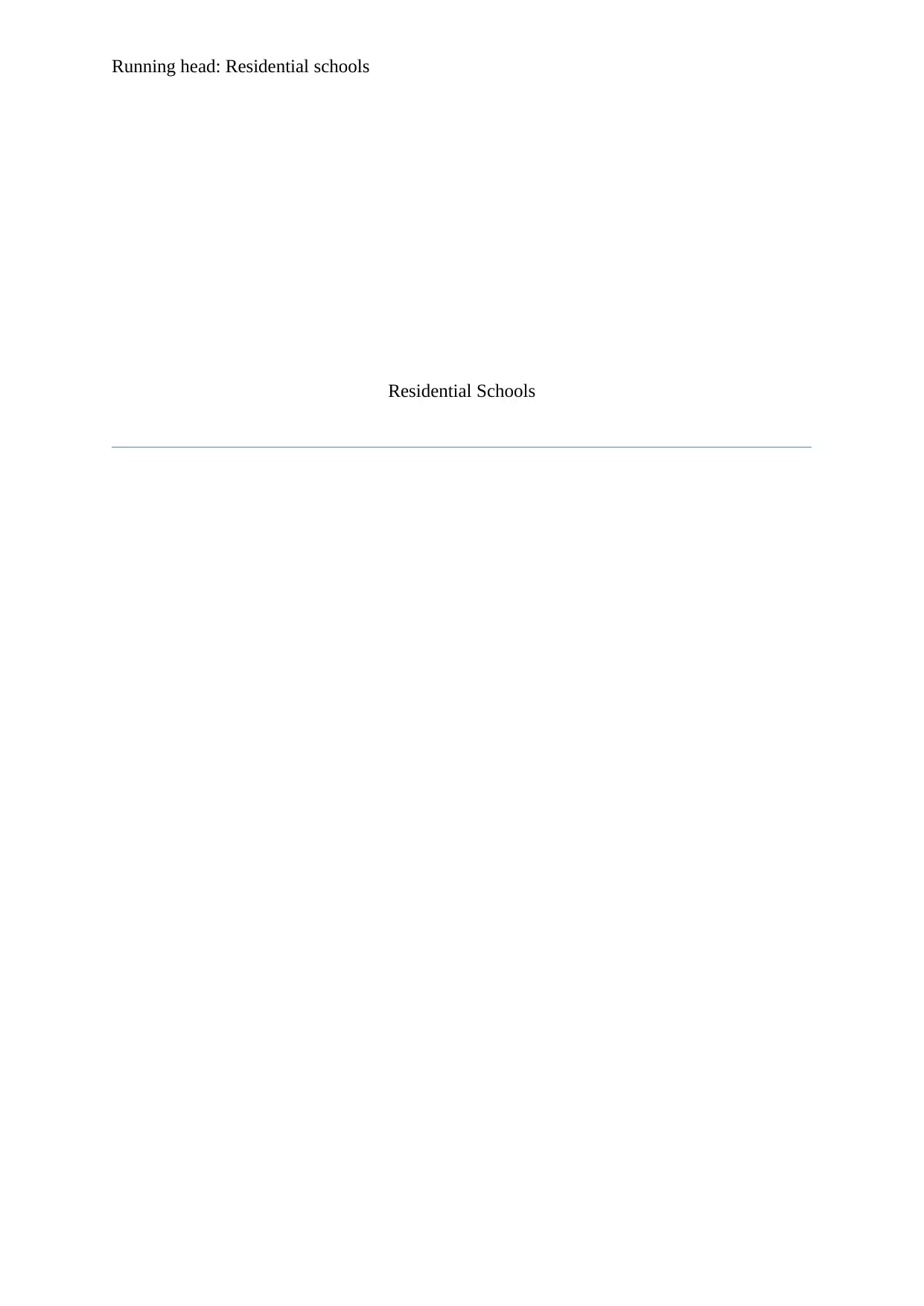
Running head: Residential schools
Residential Schools
Residential Schools
Paraphrase This Document
Need a fresh take? Get an instant paraphrase of this document with our AI Paraphraser
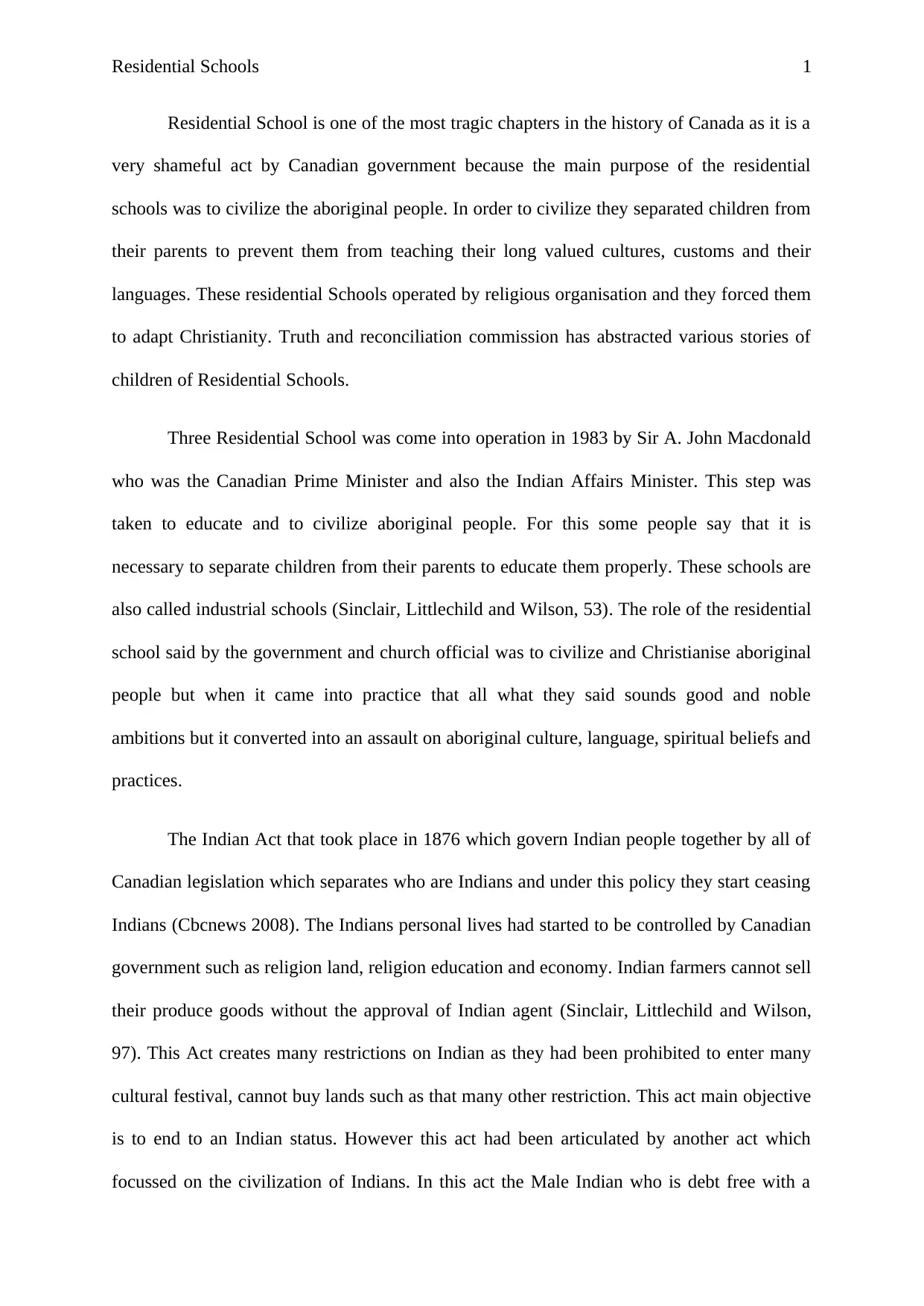
Residential Schools 1
Residential School is one of the most tragic chapters in the history of Canada as it is a
very shameful act by Canadian government because the main purpose of the residential
schools was to civilize the aboriginal people. In order to civilize they separated children from
their parents to prevent them from teaching their long valued cultures, customs and their
languages. These residential Schools operated by religious organisation and they forced them
to adapt Christianity. Truth and reconciliation commission has abstracted various stories of
children of Residential Schools.
Three Residential School was come into operation in 1983 by Sir A. John Macdonald
who was the Canadian Prime Minister and also the Indian Affairs Minister. This step was
taken to educate and to civilize aboriginal people. For this some people say that it is
necessary to separate children from their parents to educate them properly. These schools are
also called industrial schools (Sinclair, Littlechild and Wilson, 53). The role of the residential
school said by the government and church official was to civilize and Christianise aboriginal
people but when it came into practice that all what they said sounds good and noble
ambitions but it converted into an assault on aboriginal culture, language, spiritual beliefs and
practices.
The Indian Act that took place in 1876 which govern Indian people together by all of
Canadian legislation which separates who are Indians and under this policy they start ceasing
Indians (Cbcnews 2008). The Indians personal lives had started to be controlled by Canadian
government such as religion land, religion education and economy. Indian farmers cannot sell
their produce goods without the approval of Indian agent (Sinclair, Littlechild and Wilson,
97). This Act creates many restrictions on Indian as they had been prohibited to enter many
cultural festival, cannot buy lands such as that many other restriction. This act main objective
is to end to an Indian status. However this act had been articulated by another act which
focussed on the civilization of Indians. In this act the Male Indian who is debt free with a
Residential School is one of the most tragic chapters in the history of Canada as it is a
very shameful act by Canadian government because the main purpose of the residential
schools was to civilize the aboriginal people. In order to civilize they separated children from
their parents to prevent them from teaching their long valued cultures, customs and their
languages. These residential Schools operated by religious organisation and they forced them
to adapt Christianity. Truth and reconciliation commission has abstracted various stories of
children of Residential Schools.
Three Residential School was come into operation in 1983 by Sir A. John Macdonald
who was the Canadian Prime Minister and also the Indian Affairs Minister. This step was
taken to educate and to civilize aboriginal people. For this some people say that it is
necessary to separate children from their parents to educate them properly. These schools are
also called industrial schools (Sinclair, Littlechild and Wilson, 53). The role of the residential
school said by the government and church official was to civilize and Christianise aboriginal
people but when it came into practice that all what they said sounds good and noble
ambitions but it converted into an assault on aboriginal culture, language, spiritual beliefs and
practices.
The Indian Act that took place in 1876 which govern Indian people together by all of
Canadian legislation which separates who are Indians and under this policy they start ceasing
Indians (Cbcnews 2008). The Indians personal lives had started to be controlled by Canadian
government such as religion land, religion education and economy. Indian farmers cannot sell
their produce goods without the approval of Indian agent (Sinclair, Littlechild and Wilson,
97). This Act creates many restrictions on Indian as they had been prohibited to enter many
cultural festival, cannot buy lands such as that many other restriction. This act main objective
is to end to an Indian status. However this act had been articulated by another act which
focussed on the civilization of Indians. In this act the Male Indian who is debt free with a
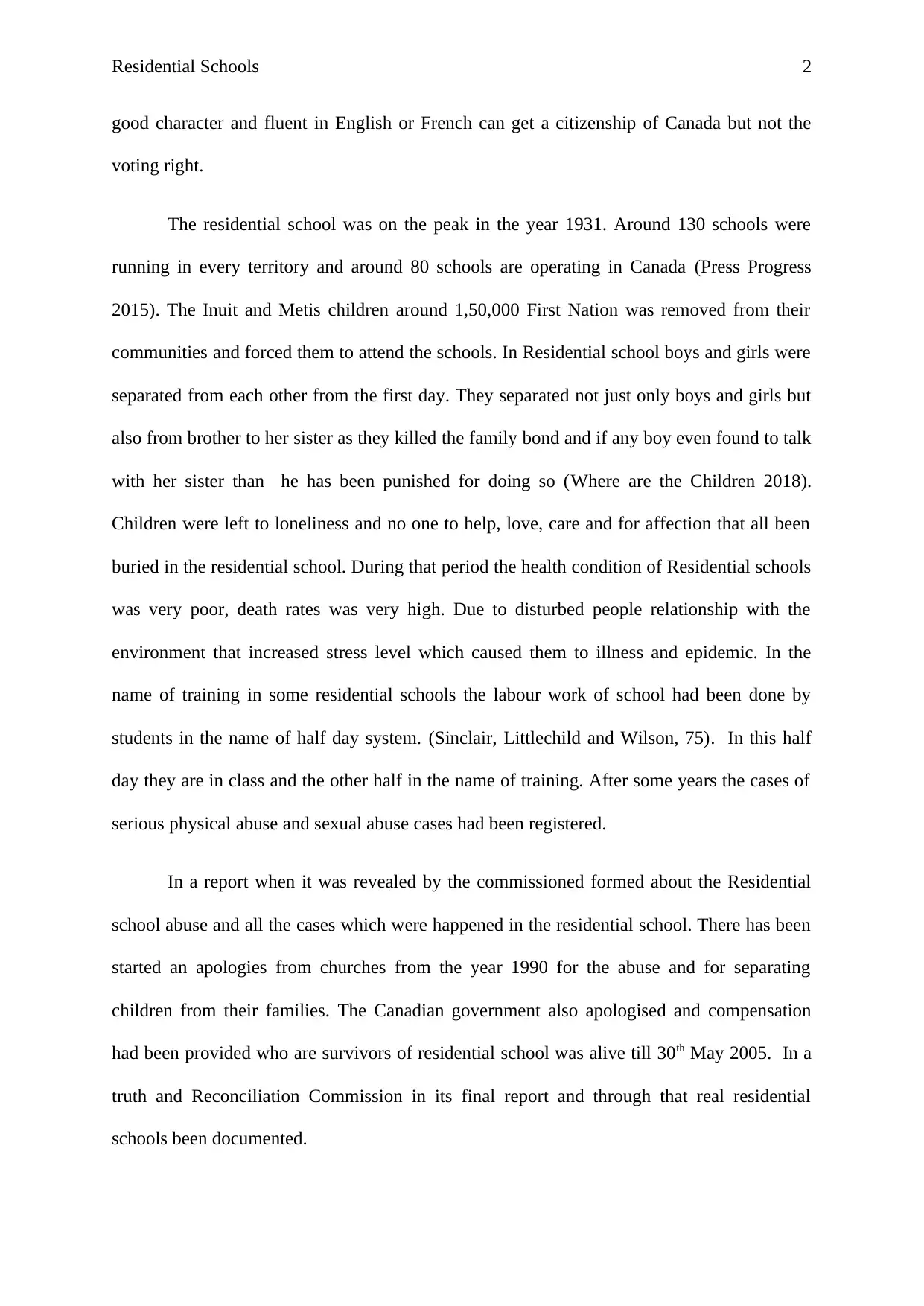
Residential Schools 2
good character and fluent in English or French can get a citizenship of Canada but not the
voting right.
The residential school was on the peak in the year 1931. Around 130 schools were
running in every territory and around 80 schools are operating in Canada (Press Progress
2015). The Inuit and Metis children around 1,50,000 First Nation was removed from their
communities and forced them to attend the schools. In Residential school boys and girls were
separated from each other from the first day. They separated not just only boys and girls but
also from brother to her sister as they killed the family bond and if any boy even found to talk
with her sister than he has been punished for doing so (Where are the Children 2018).
Children were left to loneliness and no one to help, love, care and for affection that all been
buried in the residential school. During that period the health condition of Residential schools
was very poor, death rates was very high. Due to disturbed people relationship with the
environment that increased stress level which caused them to illness and epidemic. In the
name of training in some residential schools the labour work of school had been done by
students in the name of half day system. (Sinclair, Littlechild and Wilson, 75). In this half
day they are in class and the other half in the name of training. After some years the cases of
serious physical abuse and sexual abuse cases had been registered.
In a report when it was revealed by the commissioned formed about the Residential
school abuse and all the cases which were happened in the residential school. There has been
started an apologies from churches from the year 1990 for the abuse and for separating
children from their families. The Canadian government also apologised and compensation
had been provided who are survivors of residential school was alive till 30th May 2005. In a
truth and Reconciliation Commission in its final report and through that real residential
schools been documented.
good character and fluent in English or French can get a citizenship of Canada but not the
voting right.
The residential school was on the peak in the year 1931. Around 130 schools were
running in every territory and around 80 schools are operating in Canada (Press Progress
2015). The Inuit and Metis children around 1,50,000 First Nation was removed from their
communities and forced them to attend the schools. In Residential school boys and girls were
separated from each other from the first day. They separated not just only boys and girls but
also from brother to her sister as they killed the family bond and if any boy even found to talk
with her sister than he has been punished for doing so (Where are the Children 2018).
Children were left to loneliness and no one to help, love, care and for affection that all been
buried in the residential school. During that period the health condition of Residential schools
was very poor, death rates was very high. Due to disturbed people relationship with the
environment that increased stress level which caused them to illness and epidemic. In the
name of training in some residential schools the labour work of school had been done by
students in the name of half day system. (Sinclair, Littlechild and Wilson, 75). In this half
day they are in class and the other half in the name of training. After some years the cases of
serious physical abuse and sexual abuse cases had been registered.
In a report when it was revealed by the commissioned formed about the Residential
school abuse and all the cases which were happened in the residential school. There has been
started an apologies from churches from the year 1990 for the abuse and for separating
children from their families. The Canadian government also apologised and compensation
had been provided who are survivors of residential school was alive till 30th May 2005. In a
truth and Reconciliation Commission in its final report and through that real residential
schools been documented.
⊘ This is a preview!⊘
Do you want full access?
Subscribe today to unlock all pages.

Trusted by 1+ million students worldwide
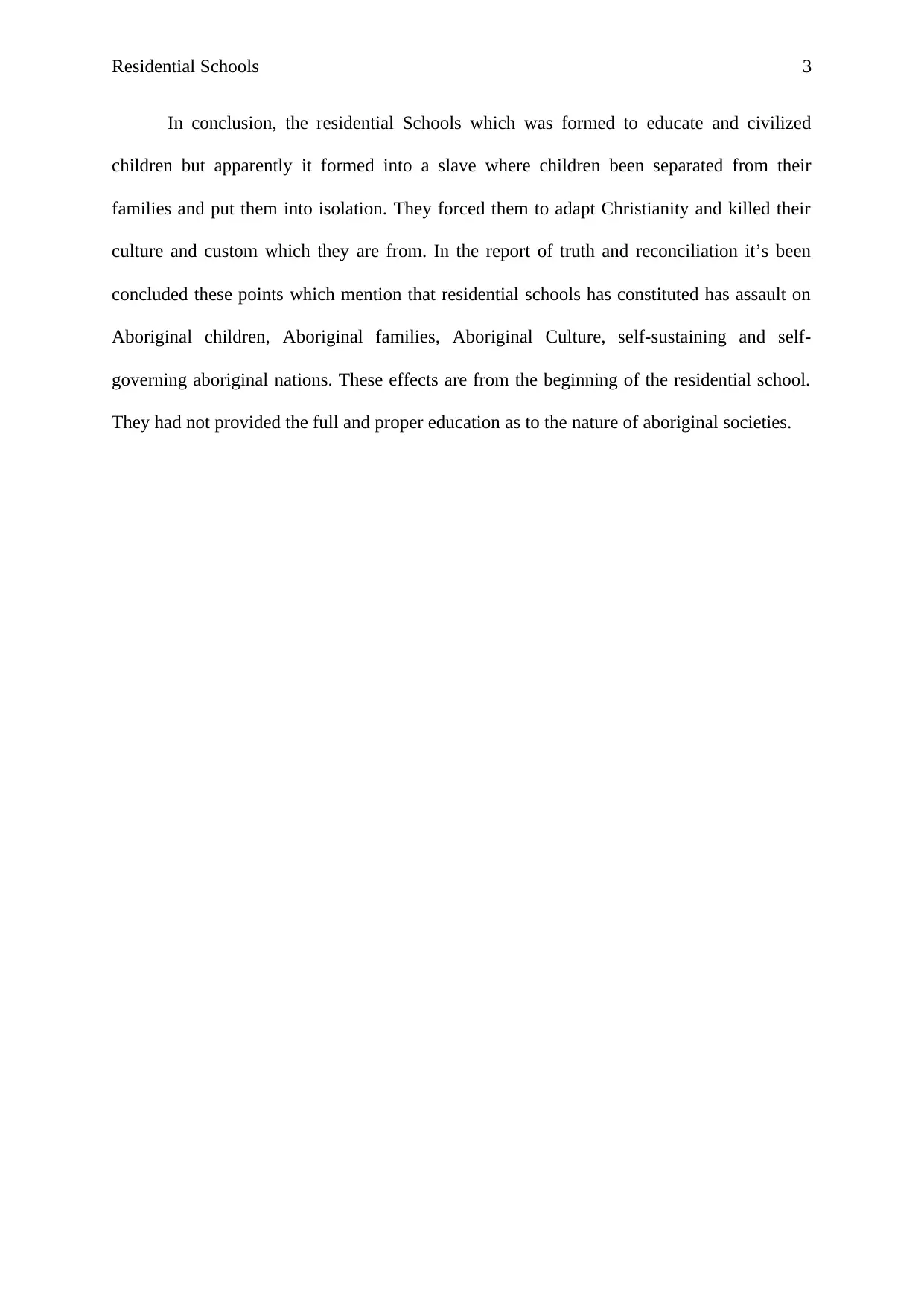
Residential Schools 3
In conclusion, the residential Schools which was formed to educate and civilized
children but apparently it formed into a slave where children been separated from their
families and put them into isolation. They forced them to adapt Christianity and killed their
culture and custom which they are from. In the report of truth and reconciliation it’s been
concluded these points which mention that residential schools has constituted has assault on
Aboriginal children, Aboriginal families, Aboriginal Culture, self-sustaining and self-
governing aboriginal nations. These effects are from the beginning of the residential school.
They had not provided the full and proper education as to the nature of aboriginal societies.
In conclusion, the residential Schools which was formed to educate and civilized
children but apparently it formed into a slave where children been separated from their
families and put them into isolation. They forced them to adapt Christianity and killed their
culture and custom which they are from. In the report of truth and reconciliation it’s been
concluded these points which mention that residential schools has constituted has assault on
Aboriginal children, Aboriginal families, Aboriginal Culture, self-sustaining and self-
governing aboriginal nations. These effects are from the beginning of the residential school.
They had not provided the full and proper education as to the nature of aboriginal societies.
Paraphrase This Document
Need a fresh take? Get an instant paraphrase of this document with our AI Paraphraser
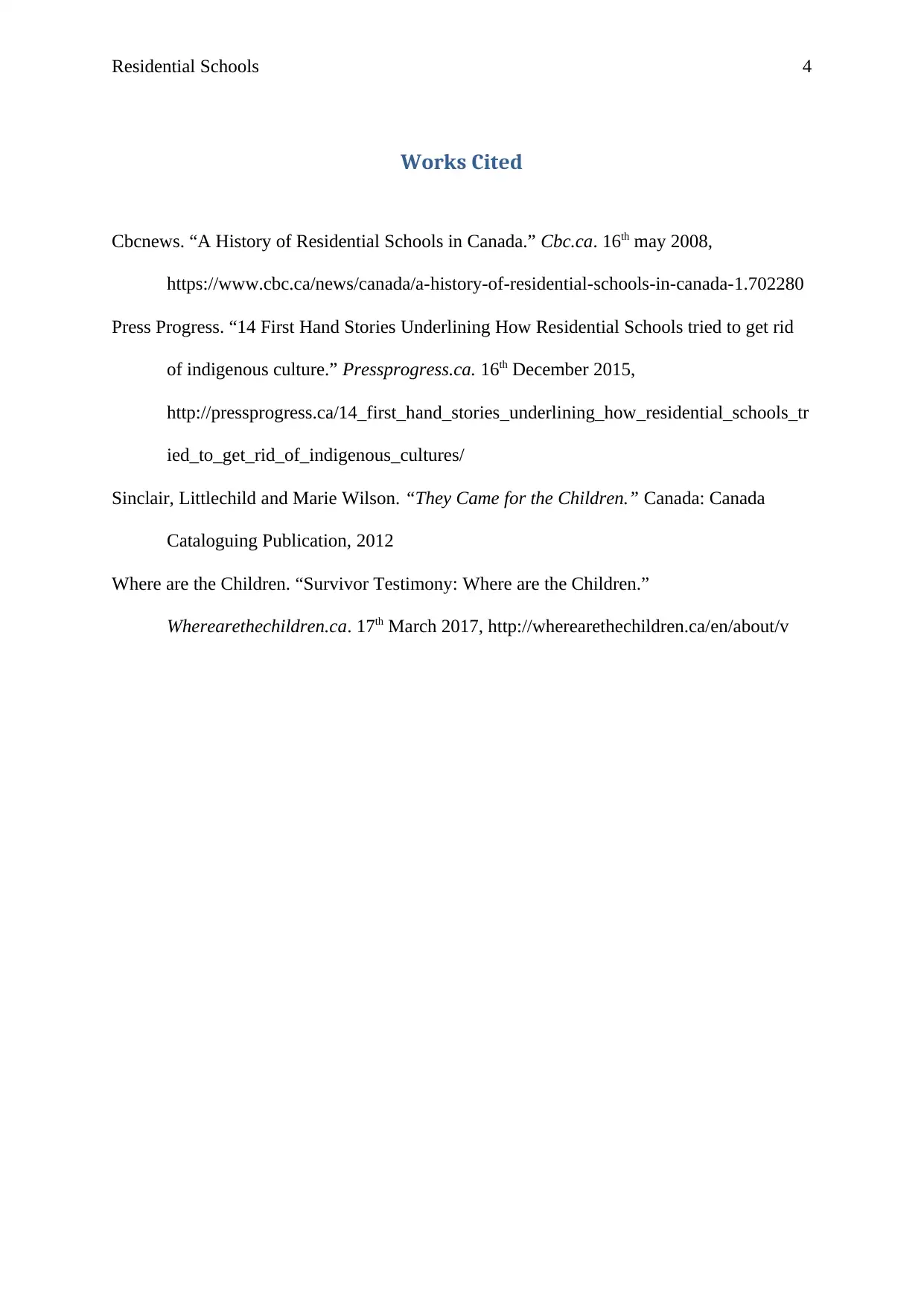
Residential Schools 4
Works Cited
Cbcnews. “A History of Residential Schools in Canada.” Cbc.ca. 16th may 2008,
https://www.cbc.ca/news/canada/a-history-of-residential-schools-in-canada-1.702280
Press Progress. “14 First Hand Stories Underlining How Residential Schools tried to get rid
of indigenous culture.” Pressprogress.ca. 16th December 2015,
http://pressprogress.ca/14_first_hand_stories_underlining_how_residential_schools_tr
ied_to_get_rid_of_indigenous_cultures/
Sinclair, Littlechild and Marie Wilson. “They Came for the Children.” Canada: Canada
Cataloguing Publication, 2012
Where are the Children. “Survivor Testimony: Where are the Children.”
Wherearethechildren.ca. 17th March 2017, http://wherearethechildren.ca/en/about/v
Works Cited
Cbcnews. “A History of Residential Schools in Canada.” Cbc.ca. 16th may 2008,
https://www.cbc.ca/news/canada/a-history-of-residential-schools-in-canada-1.702280
Press Progress. “14 First Hand Stories Underlining How Residential Schools tried to get rid
of indigenous culture.” Pressprogress.ca. 16th December 2015,
http://pressprogress.ca/14_first_hand_stories_underlining_how_residential_schools_tr
ied_to_get_rid_of_indigenous_cultures/
Sinclair, Littlechild and Marie Wilson. “They Came for the Children.” Canada: Canada
Cataloguing Publication, 2012
Where are the Children. “Survivor Testimony: Where are the Children.”
Wherearethechildren.ca. 17th March 2017, http://wherearethechildren.ca/en/about/v
1 out of 5
Related Documents
Your All-in-One AI-Powered Toolkit for Academic Success.
+13062052269
info@desklib.com
Available 24*7 on WhatsApp / Email
![[object Object]](/_next/static/media/star-bottom.7253800d.svg)
Unlock your academic potential
Copyright © 2020–2025 A2Z Services. All Rights Reserved. Developed and managed by ZUCOL.





